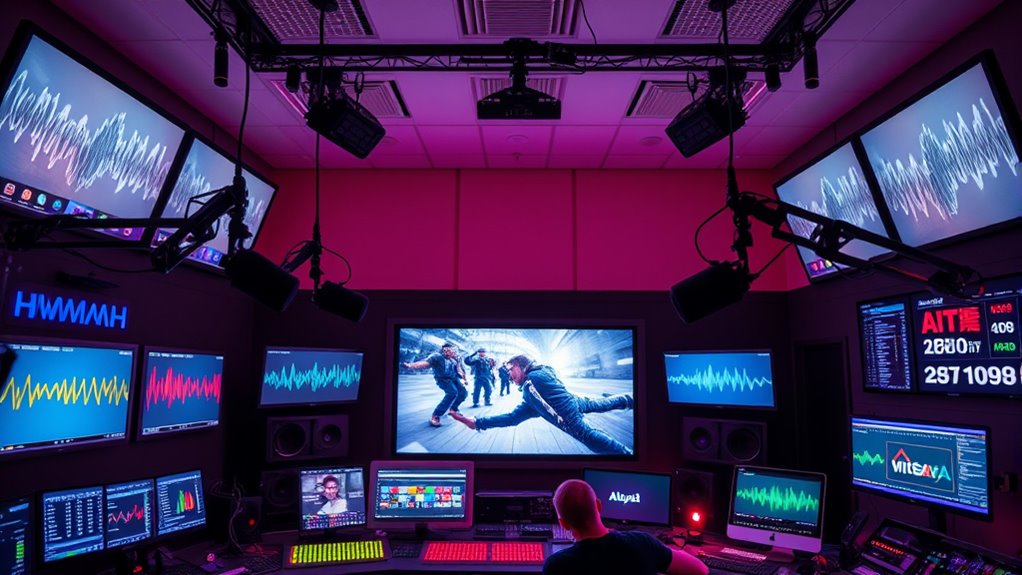Using AI-driven multi-language dubbing, you can effectively triple your content’s audience by reaching diverse markets simultaneously. This technology produces high-quality, natural voices, while cultural adaptations guarantee your message resonates locally. It accelerates production, reduces costs, and maintains consistency across languages. By combining voice synthesis with cultural tweaks, your content connects more deeply and expands globally. Keep exploring to discover how this innovative approach transforms your content strategy and maximizes your reach.
Key Takeaways
- AI-driven dubbing enables simultaneous multilingual content releases, significantly expanding global reach.
- Voice synthesis creates natural-sounding voices in multiple languages, reducing production time and costs.
- Cultural adaptation ensures content resonates locally, increasing viewer engagement and loyalty.
- Automation streamlines the dubbing process, allowing for rapid updates and multiple language versions.
- Combining these technologies can potentially triple the audience size for the same content.

AI-driven multi-language dubbing is transforming how content reaches global audiences. It’s no longer enough to produce content in one language and hope it resonates internationally. Instead, you can now leverage advanced technologies like voice synthesis and cultural adaptation to make your content more accessible and engaging across different regions. Voice synthesis, in particular, allows you to generate high-quality, natural-sounding voices in multiple languages without the need for extensive human voiceover talent. This means you can produce dubbed versions faster, cheaper, and with consistent quality, guaranteeing your message stays clear and engaging regardless of the language. The technology captures the nuances of speech patterns, intonations, and emotions, making the dubbed content feel authentic and relatable to diverse audiences.
Cultural adaptation is equally essential when expanding your content’s reach. AI-powered dubbing platforms analyze cultural differences, idiomatic expressions, and local sensitivities to customize your content for each target market. Instead of mere translation, cultural adaptation ensures your messaging resonates on a deeper level, respecting local customs and preferences. This process reduces misunderstandings or offense and helps your content feel more familiar, increasing viewer engagement and loyalty. You also gain the flexibility to tweak scripts, adjust humor, and incorporate regional references, creating a more personalized experience for every audience. Additionally, incorporating famous quotes or expressions from different cultures can further enhance relatability and emotional impact.
With AI-driven tools, you can automate much of the dubbing process, eliminating the traditional bottlenecks associated with manual voice recording and editing. This allows you to roll out multiple versions of your content simultaneously, reaching three times or more the number of viewers compared to traditional methods. It’s especially beneficial for content that needs to be updated regularly, like news, tutorials, or ongoing series, where quick turnaround times matter. Plus, since voice synthesis can replicate a consistent tone across different languages, your brand voice remains uniform, strengthening brand recognition across diverse markets.
In essence, AI-powered multi-language dubbing empowers you to break down language barriers without sacrificing quality or authenticity. By combining cutting-edge voice synthesis with thoughtful cultural adaptation, you can connect with broader audiences, boost engagement, and maximize your content’s global impact—all while saving time and costs. This approach doesn’t just expand your reach; it transforms your content into a truly international experience, making it easier to grow your presence across multiple regions simultaneously.
Frequently Asked Questions
How Does AI Ensure Cultural Accuracy in Dubbing?
AI guarantees cultural accuracy in dubbing by analyzing cultural nuances and regional dialects, enabling it to adapt scripts appropriately. It uses advanced algorithms to understand context, idioms, and slang, so the dialogue feels natural and respectful. By continuously learning from diverse data, AI can refine its translations, ensuring that regional dialects and cultural specifics are preserved, making the content more authentic and engaging for audiences worldwide.
What Are the Costs Associated With AI Dubbing?
When considering AI dubbing costs, you’ll find it’s often more affordable than traditional methods due to lower production expenses. You save on studio time and actor fees, making a cost comparison favorable. However, quality assurance is vital; you need to ensure the AI-generated dubbing maintains natural language flow and cultural accuracy. Overall, AI dubbing can be budget-friendly while delivering high-quality content, especially when you prioritize thorough quality checks.
Can AI Handle Slang and Idiomatic Expressions?
Like a modern Odysseus steering language’s treacherous waters, AI can handle slang translation and idiomatic accuracy, but it’s not perfect. It struggles with nuanced slang and cultural context, often missing subtleties. While AI makes great strides, you might need human oversight to capture the full essence of idiomatic expressions, ensuring your content resonates authentically across diverse audiences.
How Does AI Handle Voice Emotion and Tone?
You might wonder how AI handles voice emotion and tone. It uses advanced voice modulation and emotional recognition to analyze speech patterns, pitch, and pace, enabling it to mimic human emotions accurately. By identifying subtle cues, AI adjusts its voice to convey feelings like excitement, sadness, or anger, making the content more authentic and engaging. This technology helps deliver a natural, emotionally resonant experience for your audience.
What Are the Limitations of AI in Dubbing?
Think of AI dubbing like a painter with a limited palette. It struggles with maintaining voice consistency and accurately capturing regional accents, which can make characters sound unnatural or generic. AI also faces challenges in conveying subtle emotions and cultural nuances, often leading to less authentic performances. While it’s fast and cost-effective, these limitations mean it can’t fully replace human voice actors for nuanced, emotionally rich dubbing.
Conclusion
By embracing AI-powered multi-language dubbing, you’re transforming your content for a global audience—think of it as your own time-traveling DeLorean, but instead of going back to the past, you’re reaching three times more viewers today. With AI, you can quickly adapt your message across languages, breaking down barriers just like the legendary Babel Tower. So, don’t wait for a sci-fi future—start dubbing smarter now and watch your reach soar beyond borders.









